
- Spring Security Tutorial
- Sprint Security - Home
- Spring Security - Introduction
- Spring Security - Architecture
- Spring Security - Project Modules
- Spring Security - Environment Setup
- Spring Security - Form Login
- Spring Security - Custom Form Login
- Spring Security - Logout
- Spring Security - Remember Me
- Spring Security - Redirection
- Spring Security - Taglibs
- Spring Security - XML Configuration
- Spring Security Useful Resources
- Spring Security - Quick Guide
- Spring Security - Useful Resources
- Spring Security - Discussion
Spring Security - Remember Me
Remember Me is an important function of Spring Security, so that a user can remain logged in the application even when session is expired. We'll demonstrate the use of Remember Me functionality provided by Spring security in following sections.
A Remember Me functionality performs following important functions.
Firstly, it will add a "Remember Me" checkbox to default login form that we generated using formLogin().
In case of custom login form, we need to add a checkbox named "remember-me" to the form. In case of different name to be used, we need to configure the new name during Spring Security configuration as shown below:
.rememberMe().rememberMeParameter("remember")And, secondly, ticking the checkbox generates the remember-me cookie. The cookie stores the identity of the user and the browser stores it.
Spring Security detects the cookie in future sessions to automate the login. As a result, the user can access the application again without logging in again.
A remember-me can be explicitly configured as given below −
protected void configure(HttpSecurity http) throws Exception {
http
// ...
// key should be unique
.rememberMe(config -> config.key("123456")
.tokenValiditySeconds(3600))
.build();
}
Important Methods
Following are important methods that we can configure in logout() method.
rememberMe () − This will be used to implement remember me functionality. The key passed to remember-me function should be unique and secret. This key is application specific and is used to generate remember me token content.
tokenValiditySeconds () − This will be used to set the expiry of the remember me cookie. By default it has validity of 2 weeks. We can customize it any time as in above code snippet, we've set it as 1 hour using 3600 seconds.
rememberMeParameter () − This is used to mark an input check box to be remember-me checkbox. By default, its value is remember-me.
Let us start actual programming with Spring Security. Before you start writing your example using Spring framework, you have to make sure that you have set up your Spring environment properly as explained in Spring Security - Environment Setup Chapter. We also assume that you have a bit of working knowledge on Spring Tool Suite IDE.
Now let us proceed to write a Spring MVC based Application managed by Maven, which will ask user to login, authenticate user and then provide option to logout using Spring Security Form Login Feature.
Create Project using Spring Initializr
Spring Initializr is great way to start with Spring Boot project. It provides a easy to use User Interface to create a project, add dependencies, select java runtime etc. It generates a skeleton project structure which once downloaded can be imported in spring tool suite and we can proceed with our readymade project structure.
We're choosing a maven project, naming the project as formlogin, with java version as 21. Following dependencies are added:
Spring Web
Spring Security
Spring Boot DevTools

Thymeleaf is a templating engine for Java. It allows us to quickly develop static or dynamic web pages for rendering in the browser. It is extremely extensible and allows us to define and customize the processing of our templates in fine detail. In addition to this, we can learn more about Thymeleaf by clicking this link.
Let's move on to generate our project and download it. We then extract it to a folder of our choice and use any IDE to open it. I shall be using Spring Tools Suite 4. It is available for free downloading from the https://spring.io/tools website and is optimized for spring applications.
pom.xml with all relevant dependencies
Let's take a look at our pom.xml file. It should look something similar to this −
pom.xml
<?xml version="1.0" encoding="UTF-8"?>
<project xmlns="http://maven.apache.org/POM/4.0.0" xmlns:xsi="http://www.w3.org/2001/XMLSchema-instance"
xsi:schemaLocation="http://maven.apache.org/POM/4.0.0 https://maven.apache.org/xsd/maven-4.0.0.xsd">
<modelVersion>4.0.0</modelVersion>
<parent>
<groupId>org.springframework.boot</groupId>
<artifactId>spring-boot-starter-parent</artifactId>
<version>3.3.1</version>
<relativePath/> <!-- lookup parent from repository -->
</parent>
<groupId>com.tutorialspoint.security</groupId>
<artifactId>formlogin</artifactId>
<version>0.0.1-SNAPSHOT</version>
<name>formlogin</name>
<description>Demo project for Spring Boot</description>
<url/>
<licenses>
<license/>
</licenses>
<developers>
<developer/>
</developers>
<scm>
<connection/>
<developerConnection/>
<tag/>
<url/>
</scm>
<properties>
<java.version>21</java.version>
</properties>
<dependencies>
<dependency>
<groupId>org.springframework.boot</groupId>
<artifactId>spring-boot-starter-security</artifactId>
</dependency>
<dependency>
<groupId>org.springframework.boot</groupId>
<artifactId>spring-boot-starter-thymeleaf</artifactId>
</dependency>
<dependency>
<groupId>org.springframework.boot</groupId>
<artifactId>spring-boot-starter-web</artifactId>
</dependency>
<dependency>
<groupId>org.thymeleaf.extras</groupId>
<artifactId>thymeleaf-extras-springsecurity6</artifactId>
</dependency>
<dependency>
<groupId>org.springframework.boot</groupId>
<artifactId>spring-boot-devtools</artifactId>
<scope>runtime</scope>
<optional>true</optional>
</dependency>
<dependency>
<groupId>org.springframework.boot</groupId>
<artifactId>spring-boot-starter-test</artifactId>
<scope>test</scope>
</dependency>
<dependency>
<groupId>org.springframework.security</groupId>
<artifactId>spring-security-test</artifactId>
<scope>test</scope>
</dependency>
</dependencies>
<build>
<plugins>
<plugin>
<groupId>org.springframework.boot</groupId>
<artifactId>spring-boot-maven-plugin</artifactId>
</plugin>
</plugins>
</build>
</project>
Spring Security Configuration Class
Inside of our config package, we have created the WebSecurityConfig class. We shall be using this class for our security configurations, so let's annotate it with an @Configuration annotation and @EnableWebSecurity. As a result, Spring Security knows to treat this class a configuration class. As we can see, configuring applications have been made very easy by Spring.
WebSecurityConfig
package com.tutorialspoint.security.formlogin.config;
import org.springframework.context.annotation.Bean;
import org.springframework.context.annotation.Configuration;
import org.springframework.security.config.annotation.web.builders.HttpSecurity;
import org.springframework.security.config.annotation.web.configuration.EnableWebSecurity;
import org.springframework.security.config.annotation.web.configurers.AbstractHttpConfigurer;
import org.springframework.security.core.userdetails.User;
import org.springframework.security.core.userdetails.UserDetails;
import org.springframework.security.core.userdetails.UserDetailsService;
import org.springframework.security.crypto.bcrypt.BCryptPasswordEncoder;
import org.springframework.security.crypto.password.PasswordEncoder;
import org.springframework.security.provisioning.InMemoryUserDetailsManager;
import org.springframework.security.web.SecurityFilterChain;
@Configuration
@EnableWebSecurity
public class WebSecurityConfig {
@Bean
protected UserDetailsService userDetailsService() {
UserDetails user = User.builder()
.username("user")
.password(passwordEncoder().encode("user123"))
.roles("USER")
.build();
UserDetails admin = User.builder()
.username("admin")
.password(passwordEncoder().encode("admin123"))
.roles("USER", "ADMIN")
.build();
return new InMemoryUserDetailsManager(user, admin);
}
@Bean
protected PasswordEncoder passwordEncoder() {
return new BCryptPasswordEncoder();
}
@Bean
protected SecurityFilterChain filterChain(HttpSecurity http) throws Exception {
return http
.csrf(AbstractHttpConfigurer::disable)
.authorizeHttpRequests(
request -> request.requestMatchers("/login").permitAll()
.requestMatchers("/**").authenticated()
)
.formLogin(form -> form.loginPage("/login")
.defaultSuccessUrl("/")
.failureUrl("/login?error=true")
.permitAll())
.rememberMe(config -> config.key("123456")
.tokenValiditySeconds(3600))
.logout(config -> config
.logoutUrl("/logout")
.logoutSuccessUrl("/login")
.invalidateHttpSession(true)
.deleteCookies("JSESSIONID"))
.build();
}
}
Here we've mentioned the rememberMe() with a secure key for spring security.
Controller Class
In this class, we've created a mapping for "/" endpoint and for "/login" for the index page and login page of this application.
AuthController.java
package com.tutorialspoint.security.formlogin.controllers;
import org.springframework.stereotype.Controller;
import org.springframework.web.bind.annotation.GetMapping;
@Controller
public class AuthController {
@GetMapping("/")
public String home() {
return "index";
}
@GetMapping("/login")
public String login() {
return "login";
}
}
Views
Let's create index.html in /src/main/resources/templates folder with following content to act as a home page and to display logged in user name.
index.html
<!DOCTYPE html>
<html xmlns="http://www.w3.org/1999/xhtml"
xmlns:th="https://www.thymeleaf.org"
xmlns:sec="https://www.thymeleaf.org/thymeleaf-extras-springsecurity3">
<head>
<title>
Hello World!
</title>
</head>
<body>
<h1 th:inline="text">Hello <span sec:authentication="name"></span>!</h1>
<form th:action="@{/logout}" method="post">
<input type="submit" value="Sign Out"/>
</form>
</body>
<html>
login.html
Let's create the login.html in /src/main/resources/templates folder with following content to act as a login page. We're using default name username, password and remember-me for text fields. In case of other name, we need to set the same in spring security config class as well.
<!DOCTYPE html>
<html xmlns="http://www.w3.org/1999/xhtml"
xmlns:th="https://www.thymeleaf.org"
xmlns:sec="https://www.thymeleaf.org/thymeleaf-extras-springsecurity3">
<head>
<title>Spring Security Example</title>
</head>
<body>
<div th:if="${param.error}">
<p>Bad Credentials</p>
</div>
<div th:if="${param.logout}">You have been logged out.</div>
<form th:action="@{/login}" method="post">
<h1>Please sign in</h1>
<table>
<tr>
<td><label for="username"><b>Username</b></label></td>
<td><input type="text" placeholder="Enter Username" name="username" id="username" required></td>
</tr>
<tr>
<td><label for="password"><b>Password</b></label></td>
<td><input type="password" placeholder="Enter Password" name="password" id="password" required></td>
</tr>
<tr>
<td><label for="remember-me"><b>Remember Me</b></label> </td>
<td><input type="checkbox" name="remember-me" /></td>
</tr>
<tr>
<td> </td>
<td><input type="submit" value="Sign In" /></td>
</tr>
</table>
</form>
</body>
</html>
In login form, we're using POST method to login while using input fields with name and id as username, password and remember-me checkbox. If checkbox is selected, a remember-me Cookie will be created when user logs in the application.
Running the Application
As we've all component ready, let's run the Application. Right Click on the project, select Run As and then Spring Boot App.
It will boot up the application and once application is started, we can run localhost:8080 to check the changes.
Output
Now open localhost:8080, you can see our login page with Remember Me Checkbox.
Login Page with Remember Me Checkbox
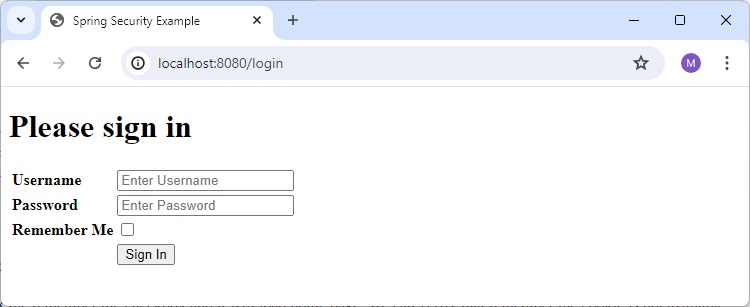
Home Page without Remember Me Checked
Enter valid credential and do not check the remember me checkbox.
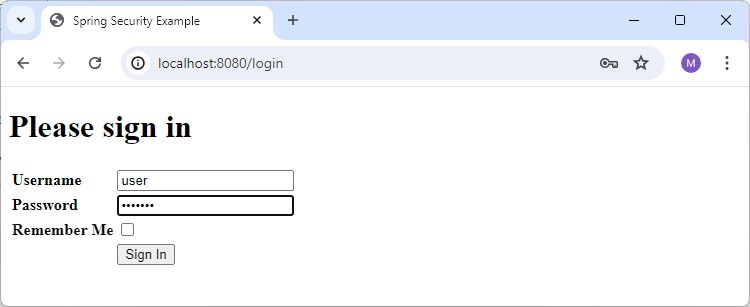
and it will load home page. We can verify that remember me cookie is not available.
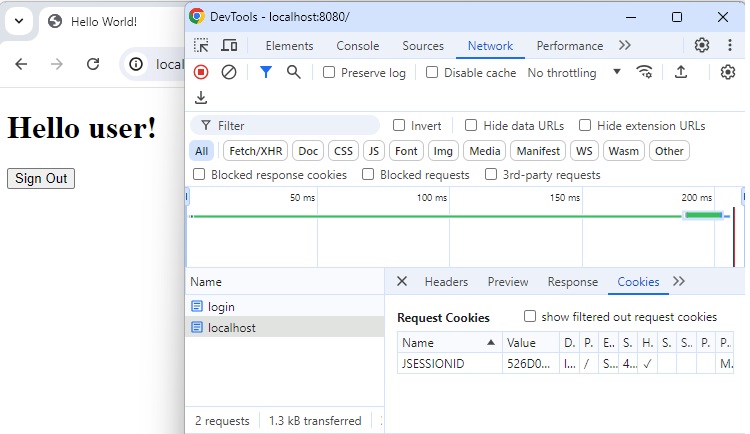
Login with Remember Me Checked
Now click on sign-out button, which will load the login page again. Check the remember-me checkbox and log-in.
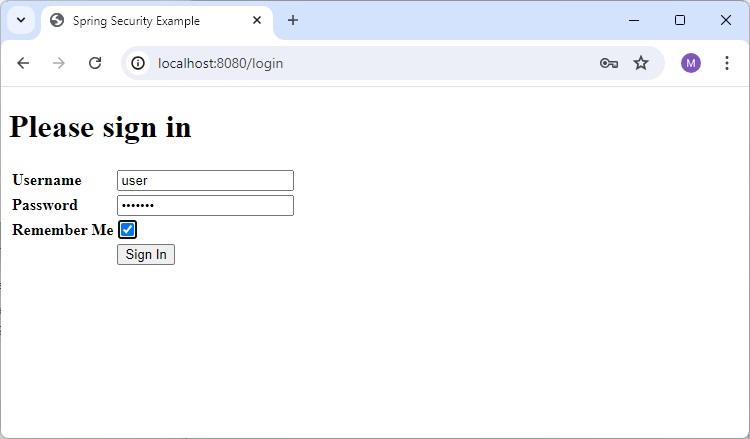
Home Page with Remember Me Checked
Now we can check that remember me cookie is now available.
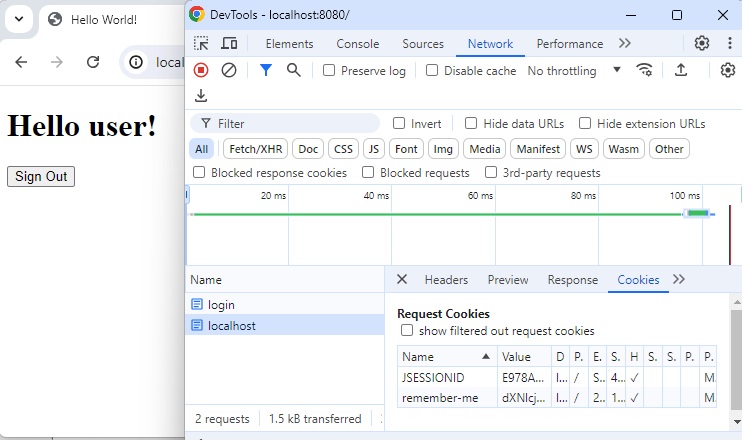
Remember Me Cookie
Remember Me cookie contains following details:
username - to identify the logged-in user. Can be used to retrieve username
expirationTime - expiry of the cookie. Default is 2 weeks.
Hash - MD5 encoded hash of username, expirationTime, password and the private key used to create cookie.
In case, username or password is changed, cookie gets invalidated and it has to created again.
If Remember Me cookie is not set, then refreshing a page will load the login page after session being timed out. Whereas if Remember Me cookie is set and active, then refreshing page will simply refresh the page and create a new session using token from Remember Me Cookie.